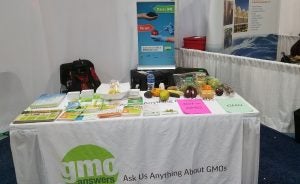Billed as the nation’s largest STEM celebration, the U.S. Science and Engineering Festival in our nation’s capital is a tour de force of shameless nerds (and aspiring ones). The event caters to youth, but mom and dad of course get corralled into attending.
Dispelling myths and making science hip is on the agenda — and that’s reflected in the diversity of participants. Whatever your interests, I’m sure they can be accommodated. The strategy goes something like this: Place a nerd or two in a 10×10 booth with props and let the public gravitate to you. Have a chat, play some games, scoop up takeaway materials, and, God forbid, learn something. Science often has the greatest measurable impact in small doses.
Though I’ve attended this expo in the past on behalf of the American Phytopathological Society (“Plant Doctors” who study organisms that make plants sick, aka specialized microbiologists) this time I attended on behalf of GMO Answers.
As an icebreaker, we had a little exercise for attendees. Without any coaching, could they lump a random assortment of crops together by their GMOness? We had eclectic goodies ranging from Romanesco cauliflower, Kiwano horned melon, Kumato (brown) tomatoes, mini red bananas, sweet potatoes, soybean and canola oil, and corn.
Generally, if it looked bizarre, it was automatically funneled into the GMO group. But looks can be deceiving. So which were bona fide GMOs? According to the Feds, only the last three. With that said, thousands of years ago, bacteria had an amorous encounter (of sorts) with a sweet potato. This nonsexual healing led to genetic leftovers being gifted to the sweet potato. This casual handoff, called horizontal gene transfer, happens all the time in nature. Humans have viral genes in them, ergo, humans are technically GMOs. So much for the sanctity of species. What a great way to debunk the stereotype of GMOs as oddities of nature.

Edibles are a surefire draw to satisfy curiosity (and the tastebuds). Wasn’t it irritating when mom would pack you apple slices and they’d be brown mush by lunch? That’s compliments of an enzyme that starts to break down apple tissue once cut. Fortunately, we had some Arctic Apples (ultra-slow browning) to distribute. Also a Gen3 GMO crop, more consumer friendly.
That leads into the next point — science literacy. Take a peek at some of the Arctic Apple reviews on Amazon. “This uses gene silencing technology, so it’ll turn off your genes!” (It won’t — and it’s inspired by, you guessed it, nature). But this is pretty symbolic of why it’s critical to have an outreach presence.
The festival was a prime opportunity to take the GMO pulse of participants. How would they respond? For agvocates, this is a chance to polish the message. I spoke with attendees one on one or in small groups, with no alienating lingo. Just a friendly back and forth in a non-threatening environment. Literally “ask me anything, let’s have a conversation.” A judgement-free zone.
I revel being in this heightened ecosystem, with individuals who are generally more science savvy and receptive — but you’re not always preaching to the choir. I entertained a number of well-thought out questions, but certain ones seemed to get the most mileage:
- “Don’t I have a right to know if GMOs are in my food?
- “What about the uptick in allergies and autism? Doesn’t this coincide perfectly with the release of GMOs?”
- “If GMOs are so safe, why are they banned in Europe?”
- “I’ve heard that GMOs aren’t tested. Is this true?”
- “Who funds you? Where are your allegiances? Is this just a front for big ag?”
In retrospect, what I found was a sometimes tragic confluence of science literacy littered with dissonance, especially when it clashed with their own worldview. In particular, I encountered quite a bit of “Euroscepticism” when it came to GMOs. And that’s not to single Europeans out. A few Americans had the same viewpoint. They were insistent on labeling and held fast to their organic creed. But that doesn’t make them uneducated, just miseducated. They asked the right questions, and I had the most productive conversations with them by far.
As agvocates, we can bemoan the decline of expertise or get out on the circuit and stump for sound science — writing editorials, speaking at events, and leveraging social media. Only then can we tip the scales on biotech education. It seems to be paying off. Youth are already more inclined to favor GMOs and other scientific advancements. In the quest to get the word out, skepticism might reign, but at least you’ve planted that subversive seed.
Tim Durham’s family operates Deer Run Farm — a truck (vegetable) farm on Long Island, New York. As an agvocate, he counters heated rhetoric with sensible facts. Tim has a degree in plant medicine and is an Assistant Professor at Ferrum College in Virginia.



